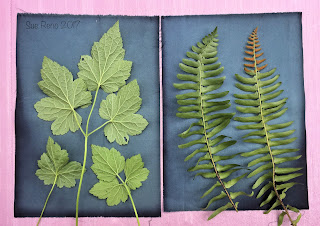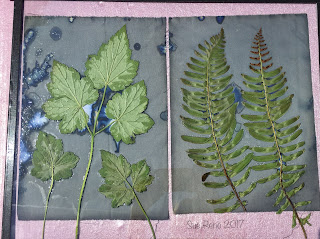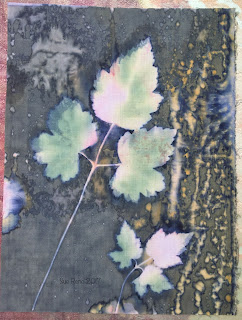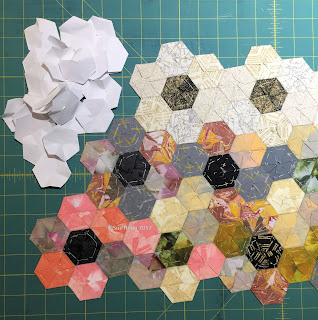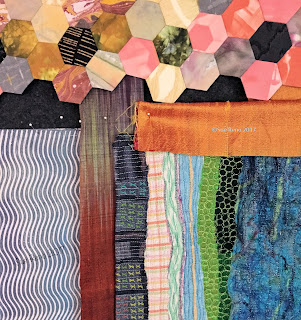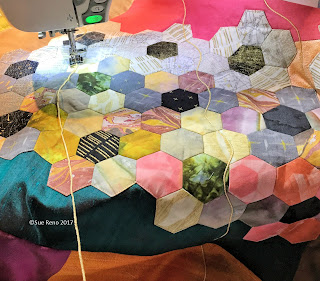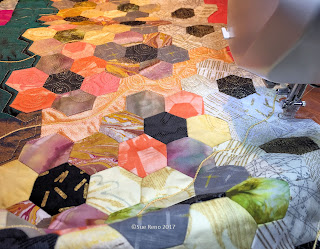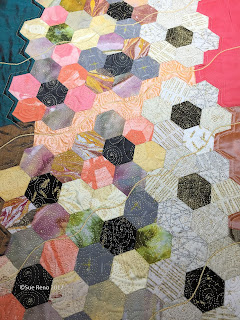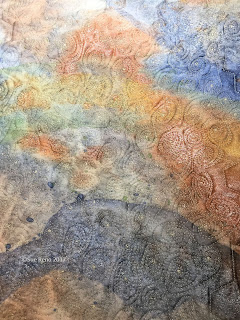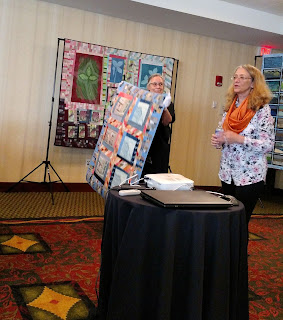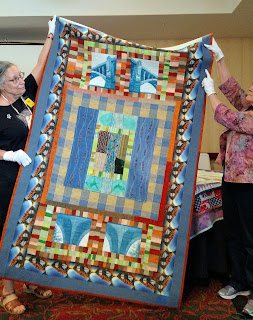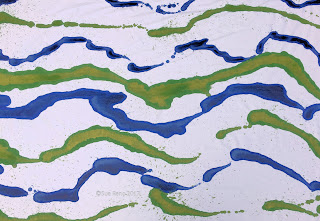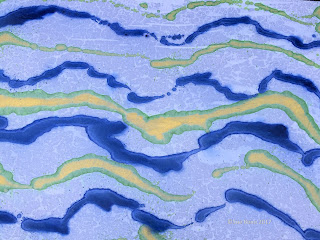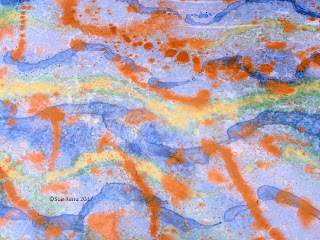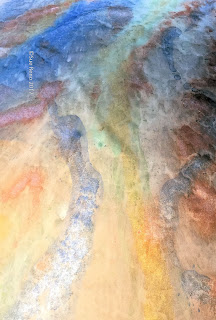Lately I've been intrigued by several Instagram accounts of artists featuring wet cyanotypes, tagged #wetcyan. There are lots of variations, and most artists are working on paper, but the main idea is to incorporate moisture and go for very long exposure times, 24 hours or more (a normal exposure is 10 minutes). The process breaks down the chemicals to produce swirls and colors shifts in the prints, and I find that beautiful and intriguing. So I decided to give it a try.
I started with cotton sateen that I had treated in November, laid on a foam insulation board. I laid down Japanese anemone leaves and Christmas fern fronds as my resist. I used a sprayer to mist water on a pane of glass and covered it all up. I set it all in a sunny location on a very hot afternoon. (All pictures blow up when clicked.)
After a half hour I could see funky things beginning to happen, but I was concerned I hadn't added enough moisture, so I spritzed a bit more around the edges and let it creep in.
The next day brought a forecast for heavy thunderstorms, so after 18 hours I pulled the prints and brought them indoors. Here's how they looked at that point:
They were fairly moist, and I thought it wouldn't hurt and might help if they dried before rinsing, so I put them in a dark room for several hours. Finally, I rinsed them out and dried them. This is how they finished:
I'm happy with the results. I love all the subtleties of tone, and the golden and greenish tints.
But wait, there's more! In the fall of 2015 I made a lot of samples for an article on cyanotype printing I was writing for Quilting Arts Magazine. Towards that end I bought some pre-treated cotton cyanotype fabric from a new-to-me online supplier. It was an OK product, certainly competitively priced, but loosely woven muslin, and not heavily saturated with chemical. After making the samples I had set the rest aside. By now the fabric was well past its prime, but it seemed like a good candidate for experimentation since I had nothing to prove and nothing to lose. So I set up a parallel exposure, this time with a painted fern and Japanese anemone leaves. For this one I misted the foam board as well as the glass.
I could see the chemicals moving around the fabric immediately:
After the same 18 hour exposure, here were the unwashed prints.
After drying and rinsing, they turned out like this. Very cool!
I was a bit mystified by the pink tones at first. Then I realized that I had used that foam board for making painted prints previously. I always clean it off, and I've never had the leftover paint stains transfer before, but I'm speculating that cooking in the sun on a hot day may have loosened some of the red pigments.
This was successful and interesting enough that I'm going to give it another round of experimentation. Stay tuned!
July 2022 Update: This post has been doing some numbers, so I wanted to say hello, and thank you, to everyone stopping by. I also wanted to let you know that this exploration turned into a series of 78 posts, and counting! You can easily access them, in reverse chronological order, by clicking on the Wet Cyanotype tab in the top header. I share a lot of details about what I've tried, and am always honest about the results in each post. Mixed in is the occasional post showing artquits I've made with my prints. I hope you enjoy reading my blog, learn a thing or two, and try your own hand at this very enjoyable process.
Thanks as always for reading! You can also follow along on your platform of choice:
Facebook page:http://www.facebook.com/suerenostudio
Twitter feed: http://twitter.com/suereno (on hiatus right now)
Tumblr: http://suerenostudio.tumblr.com
Instagram: https://www.instagram.com/sue_reno_studio/
Twitter feed: http://twitter.com/suereno (on hiatus right now)
Tumblr: http://suerenostudio.tumblr.com
Instagram: https://www.instagram.com/sue_reno_studio/
August 2023 Update: Still doing some numbers, still doing new experiments! I'm up to Experiments in wet cyanotype - part 83 and I continue to be grateful for all the interest and support. Here's the updated list of my socials, I'd love to have you follow along on the platform of your choice:
Threads: sue_reno_studio@threads.net
Facebook page:http://www.facebook.com/suerenostudioTumblr: http://suerenostudio.tumblr.com
Instagram: https://www.instagram.com/sue_reno_studio/
